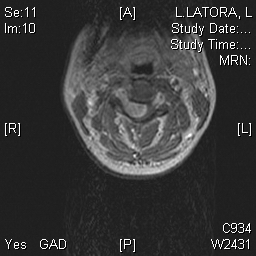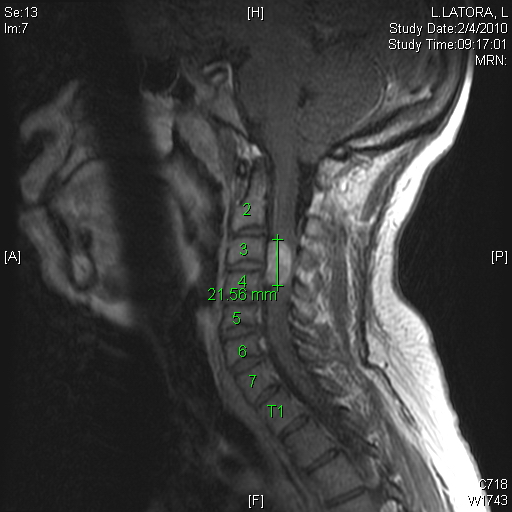Case Presentation: We report a 32 yr old HIV positive lady who presented with acute onset right thoracic multi-dermatomal herpes zoster and ipsilateral upper and lower limb weakness. She had been on HAART since 2002 but stopped her medications for few months prior to presentation. Her examination was significant for right side localized vesicular rash in dermatomes T4/T5 and right UE and LE UMN type of weakness with positive ankle clonus. CBC, BMP and LFT were normal. However, her CD 4 count was 8 and viral load by RT-PCR detected 2832 copies/ml. Her presentation was initially attributed to VZV and treatment with high dose acyclovir initiated in addition to contact and respiratory isolation. However, cervical spine MRI revealed right extra-medullary, intradural mass compressing the cervical spinal cord at C3/C4 and the right C4 root. Patient stabilized with high dose dexamethasone and started improving following partial C2, C3, C4 laminectomies and excision of the tumor followed by 5040cGy of RT and aggressive physical therapy. Pathology of the excised tumor revealed leiomyosarcoma with in-situ hybridization of EBV early RNA staining the neoplastic cells strongly. Patient did well during 2 years of follow up with recurrence at the same site after 2 years. Her care was transferred for cyber knife therapy to a higher center.
Discussion: EBV associated leiomyosarcomas are a rare subset of tumors reported in HIV infected patients and solid organ transplant recipients. Smooth muscle tumors are the second most common pediatric AIDS population but data in adult literature is limited. The role of EBV in oncogenesis of smooth muscle tumors is considered causative but putative mechanisms are unknown. Kenneth LM et al demonstrated clonality of EBV genome, hence arguing against post malignant transformation infection of neoplastic cells. Primary Intraspinal leiomyosarcomas are an extremely rare entity with less than 10 cases reported in adult literature (1). The most common reported site has been thoracic and classically, they occur as contrast enhancing ovulated mass with intramedullary primary with foraminal extension. Surgical excision is usually the treatment of choice with best chance of cure. Anecdotal evidence suggests improvement in immune status decreases the likelihood of recurrence with radiotherapy offering marginal additional benefit. No real experience with chemotherapy exists due to the infrequent nature of these tumors.
Conclusions: As a hospitalist caring for HIV patients, it is imperative that clinicians are aware of rare tumors especially in a patient presenting with multidermatomal herpes zoster. EBV associated tumors are becoming more common in the setting of HIV and organ transplant recipients.


